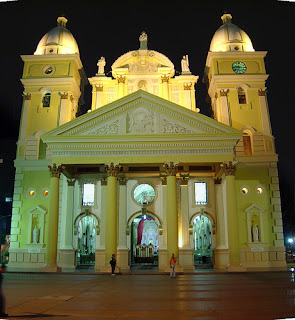 An old lady named Maria Cárdenas made a living by washing other people's clothes, a job she did every morning at the shores of the lake. On November 18, 1709 she took a bulk of clothes, and as usual, went to the lake to start washing them. This old lady was at her chores when she saw a small wooden slab floating towards her. She picked it up thinking that it might be of some use.
An old lady named Maria Cárdenas made a living by washing other people's clothes, a job she did every morning at the shores of the lake. On November 18, 1709 she took a bulk of clothes, and as usual, went to the lake to start washing them. This old lady was at her chores when she saw a small wooden slab floating towards her. She picked it up thinking that it might be of some use.When Cárdenas finished her work, she went home carrying the clothes, the wooden slab and a small vase with fresh water. She then placed the board on top of the vase, before noticing a small figure in the board but could not tell what it was. Feeling curious about this, she went directly to see what was happening and found the slab glowing with a bright light to later find the image of the Virgin of Chiquinquirá.
Our Lady of the Rosary of Chiquinquirá or the Virgin of Chiquinquirá is a title given to the Blessed Virgin Mary in the northern Andeanregion of South America. She is the patron saint of Colombia, the Venezuelan state of Zulia, and the town of Caraz in Peru.
In Colombia, her painted image rests in the Basílica of Our Lady of the Rosary in Chiquinquirá, where thousands of pilgrims arrive not only for the Feast Day on July 9, but also every Sunday, when they celebrate masses and processions. On July 3, 1986, Pope John Paul II visited the sanctuary and prayed for peace in Colombia at the feet of the Virgin Mary's image. The title given to the Virgin is from the city of Chiquinquirá, where the first of the Virgin's miraculous manifestations occurred, and where the original image from the sixteenth century is kept.
An image of the Virgin of Chiquinquirá can be found at the Basílica of Maracaibo, in Maracaibo, Venezuela, where it is also called La Chinita. Every November 18, the city celebrates the traditional Feast of La Chinita with masses and processions in honor of the Virgin.
Since the wooden slab depicting the image of the Virgin Mary arrived to the shores of Maracaibo 298 years ago, the Marian faith has grown exponentially. It was first taken to a small sanctuary built to honor San Juan de Dios and later, under the rule of the governor Francisco de la Roche Ferrer, a bigger chapel was erected to venerate the newly found Virgin of Chiquinquirá. The wooden slab remained in there for the next generations until the final stage of the Basilica was completed in 1858.
Annual Celebration
The people of Maracaibo celebrate the Chinita's fair in November with an all-night party. One of the main city avenues, Bella Vista, is closed for several blocks and the city puts lights along the whole avenue. The lights stay up for months, until after Christmas. There are stages set up, sponsored by the government and businesses around the city. There are firework shows and street vendors, and hundreds of thousands of people line the streets and celebrate all night.
The Chinita’s fair officially begins on October 27th when the Virgin is taken down from the altar in which she rests. She tours all over the Zulia State and returns to the Basilica to start all the religious festivities. Around October 2nd, Bella Vista Avenue sees itself lit up by all the Christmas decorations and the local government promotes a series of public concerts with national and international artists to begin the “real” fair. Crowds of people flock together to the different stages or platforms devised to house such concerts.
Other cultural activities are held during the fair. Expo-Zulia is a temporary marketplace where the zulians show a great deal products that characterize our region. Many merchants, stores, companies and artisans offer their products at reasonably low prices. The Bullfights are also popular and a number of these are held in our bullring. The “

No hay comentarios:
Publicar un comentario